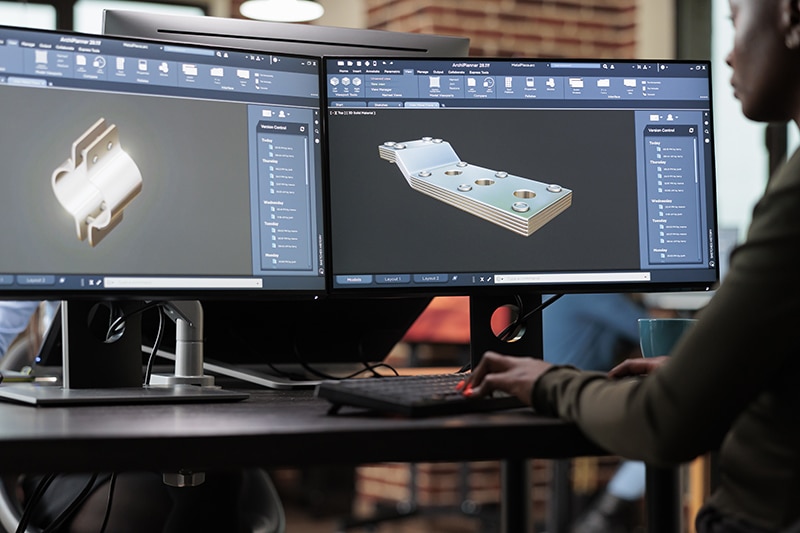Businesses convert their documents to different formats for various reasons. Document conversion enables them to convert documents to different formats for long-term storage and easy retrieval. It allows them to organize their documents for use across several platforms. PDF to CAD conversion is a crucial tool for businesses involved in design, engineering, and architecture. It provides designers with a broader set of tools and capabilities translating 2D or 3D design data from the PDF files to CAD formats while preserving all necessary dimensions and design elements. Many businesses depend on expert PDF to CAD conversion services to complete the process seamlessly. Working with an expert will preserve accuracy and scale, ensuring reliable results within the specified timeframe.
PDF and CAD Formats
Designers, engineers, and architects use CAD or computer aided design to create, modify, analyze, and optimize 2D and 3D models of physical objects or systems. It replaces traditional manual drafting methods. With 3D CAD, you can easily exchange, review, simulate, and alter designs, opening the door to unique and new items that reach the market quickly. The majority of cutting-edge CAD programs employ DWG or DXF files to effectively store two and three-dimensional design data. Although the design data is typically rather large in this format, there are many advantages for design experts.
PDF is a flexible file format that can store any combination of raster images, text, and 2D vector drawings. PDF files can be viewed and accessed on different operating systems (Windows, macOS, Linux) and devices (computers, smartphones, tablets) without any specific software requirements. This file format preserves the layout, formatting, and fonts of the original document regardless of the device or software used to open them. While many PDF files are intended to be non-editable, there are various methods and software tools available to modify PDF content, depending on the specific requirements and permissions associated with the file. PDF is now an officially recognized global standard for the exchange of documents and data.
Reasons to Convert PDF Files to CAD Format
- Absence of original CAD design: In order to begin the design process for any future extensions, additions, or renovations to your building, you need the original CAD plans. You can use PDF to CAD conversion to get these designs from PDF copies you already have if you’ve lost, misplaced, or simply don’t have access to them. With reliable document conversion services, you will receive superior-quality drawings for the design process.
- Protection of experts’ interests: CAD conversion can play a significant role in safeguarding the financial and professional interests of architects and other professionals in the field. By converting their design files into CAD formats, they can secure their intellectual property rights. CAD files can be easily protected with passwords or encryption, preventing unauthorized access and ensuring that only authorized individuals can modify or use the designs.
5 Ways PDF to CAD Conversion Streamlines Workflow
- Provides editable design data: Despite being widely used for document sharing and reading, PDF files cannot be directly modified. Editable data is essential for making alterations, iterations, and revisions in design and engineering projects. Design experts can adjust and change the geometry, dimensions, and components of the original design thanks to CAD formats like DWG (Drawing) and DXF (Drawing Exchange Format). For designers, engineers, and architects, converting PDF files into CAD opens up a world of possibilities by making it easy for them to access and change design data. This capability maintains design accuracy, supports effective decision-making, and streamlines the collaboration process.
- Correction of missing information in PDF file: Some PDF files may contain scans of actual designs, capturing only a portion of the design features or sometimes incomplete information. In such cases, the conversion process might struggle to comprehend and reproduce the missing elements, leading to an incomplete CAD model lacking crucial information. Additionally, the absence of text information in PDFs can present another potential challenge. These missing components can adversely affect the fidelity of the final CAD model, leading to inaccuracies in measurements, dimensions, and overall design representation, potentially resulting in costly errors during manufacturing or construction.To tackle these issues, businesses often turn to specialized PDF to CAD conversion services. By converting PDF files to CAD format, they can maintain the necessary precision, scale, and details, facilitating a seamless transition from design to execution while minimizing the likelihood of errors.
- Streamlines Production and Manufacturing: CAD files play a vital role in various industrial sectors as they serve as the blueprint for producing tangible goods. To facilitate a smooth transition from design to manufacturing, it is essential to convert PDF files into CAD format. By doing so, manufacturers can optimize material usage, streamline operations, and eliminate errors by utilizing accurate and comprehensive CAD models. The use of CAD data ensures that the final product aligns precisely with the planned design parameters during 3D printing and CNC (Computer Numerical Control) machining processes. As a result, this leads to the production of higher-quality products and increased productivity, ultimately benefiting the industrial sectors.
- Addresses complexity of PDF: Large PDF files with numerous pages or high-resolution graphics can consume significant processing power and require a substantial amount of time for conversion. The complexity of the PDF directly affects the duration needed to extract the design data and convert it into a CAD-compatible format. Such delays can hinder the completion of design and engineering tasks, leading to extended project schedules. Moreover, large file sizes may result in increased costs, especially when using cloud-based conversion services or outsourcing to external vendors. To overcome these challenges, businesses can opt to utilize specialized CAD conversion services. These services are specifically optimized to handle intricate designs and streamline the conversion process, ensuring faster and more accurate results. By leveraging such services, companies can alleviate the difficulties associated with converting large PDF files into CAD formats, enhancing overall efficiency and productivity in design and engineering workflows.
- Increases interoperability and compatibility: CAD files work with a wide range of design and engineering software programs and have become an accepted industry standard. Converting PDF files into CAD formats promotes interoperability between different design software and platforms. Regardless of the program they use, this seamless connectivity promotes collaboration among many teams, departments, and stakeholders.
Modern design and engineering operations clearly show the value of converting PDF files into CAD formats. It makes editable design data possible, maintains accuracy and scale, improves compatibility and interoperability, speeds production procedures, and minimizes errors.
Before selecting a document conversion service provider, make sure to research and compare different companies to ensure they meet your specific requirements in terms of accuracy, file format support, pricing and customer support.
Tired of struggling with PDF files that lack editable design data and precision?
Try our PDF to CAD Conversion services.
PDF to CAD Conversion services utilize specialized tools and a team of experienced professionals to ensure accurate and efficient conversions. By entrusting the task to these experts, businesses can rest assured that their PDF files will be transformed into precise and editable CAD formats with precision. This not only saves time and effort but also enhances collaboration, streamlines workflows, and facilitates seamless integration into existing design and engineering processes.




